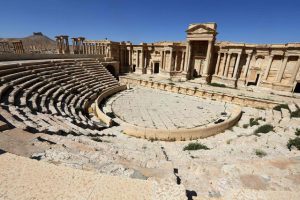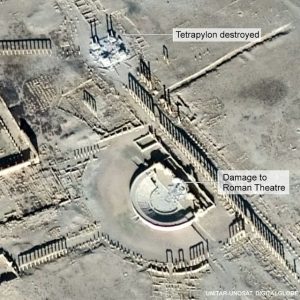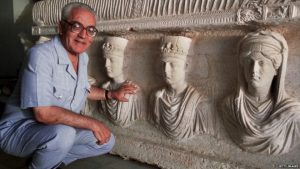Conflict and warfare have always posed threats to buildings and sites that hold cultural significance. Examples range from the destruction of Tenochtitlán during the Spanish ‘conquest’ to current destruction of sites in the Middle East by the Islamic State. ISIS’s destruction of one site in particular, Palmyras in Syria, has recently made news. Palmyras was a city at the crossroads and major trading center between the Mediterranean and Mesopotamia.
Though records of the city go back for 3,800 years, the height of the city was under Roman occupation in the 3rd century A.D. Its mix of merchants from many cultures lead to Palmyras’ unique architecture and blend of Roman and Near Eastern styles (Romey). Palmyra was once of Syria’s most popular tourist location, until the outbreak of conflict in 2011 (Romey).
ISIS first captured Palmyra in May 2015, but were driven out by regime forces. They then retook the city on December 11, 2016 (Deeb). An ISIS leader announced in a radio broadcast on May 27, 2015 that the ruins in Palmyra would not be damaged (Almukhtar). However, as Syrian government forces moved closer to the city, the ISIS began to bulldoze and detonate structures such as the Roman Theater known as the Tetrapylon (2nd cen. AD), the Temple of Bel, which dated back to A.D. 32, and the Temple of Baalshamin. Before demolishing the theater they used it as a stage for executions and propaganda.
In August 2015 they executed Khaled al-Asaad, the former director of the Palmyra museum, outside the museum next to the ruins (“Syrian archaeologist killed in Palmyra by IS militants”).
al-Asaad was imprisoned for a month before his execution, during which time ISIS members interrogated him about the location of valuable artifacts. One of ISIS’s main sources of revenue is the sale of artifacts they have looted (Harkin). In addition to looting sites, it is clear that ISIS has been using the archaeological site as a literal stage to give them national attention and advertize their platforms.
The destruction of these sites has been called a “war crime” by the the UNESCO spokesperson (“Palmyra’s archaeological heritage under ISIS attack”). Palmyra was a crossroad of different cultures and religions, which is evident in the fusion of Roman, Greek, and Near Eastern architecture. It has a “spirit of… encounter and openness” (“Palmyra’s archaeological heritage under ISIS attack”). It is this spirit, which the historical site embodies, that makes it so anathematic to ISIS. By destroying the historical evidence of religious and cultural tolerance and killing people that share this knowledge like al-Asaad, ISIS hopes to destroy the future of tolerance in this area.
Work Cited:
Almukhtar, Sarah. “The Strategy Behind the Islamic State’s Destruction of Ancient Sites.” The New York Times. The New York Times, 01 July 2015. Web. 30 Mar. 2017.
Deeb, Sarah El. “ISIS Destroys Part of Palmyra’s Roman Theatre.” The Archaeology News Network. The Associated Press, 20 Jan. 2017. Web. 30 Mar. 2017.
Harkin, James. “The Race to Save Syria’s Archaeological Treasures.” Smithsonian.com. Smithsonian Institution, 01 Mar. 2016. Web. 30 Mar. 2017.
“Palmyra’s Archaeological Heritage under ISIS Attack.” ARA News, 21 Jan. 2017. Web. 30 Mar. 2017.
Romey, Kristin. “Why Palmyra, Recently Liberated, Is a Historical Treasure.” National Geographic. National Geographic Society, 28 Mar. 2017. Web. 30 Mar. 2017.
“Syrian Archaeologist ‘killed in Palmyra’ by IS Militants.” BBC News. BBC, 19 Aug. 2015. Web. 30 Mar. 2017.
Further Reading:
Video showing more of Palmyra’s ruins before ISIS: https://www.nytimes.com/video/world/middleeast/100000003870889/video-shows-palmyra-ruins-before-isis.html?action=click&contentCollection=world&module=embedded®ion=caption&pgtype=article
More on the destruction of the Temple of Baal: https://www.nytimes.com/2015/09/01/world/middleeast/isis-militants-severely-damage-temple-of-baal-in-palmyra.html
More on the destruction of Palmyra: https://www.nytimes.com/2015/09/01/world/middleeast/isis-militants-severely-damage-temple-of-baal-in-palmyra.html
List and descriptions of other sites ISIS has damaged or destroyed: http://news.nationalgeographic.com/2015/09/150901-isis-destruction-looting-ancient-sites-iraq-syria-archaeology/
More on ISIS’ looting of antiquities to fuel the Iraq Insurgency: http://news.nationalgeographic.com/news/2014/06/140626-isis-insurgents-syria-iraq-looting-antiquities-archaeology/





Despite the new waves of destruction at Palmyra there has been an active movement in the digital preservation of the site. The new Palmyra project(http://www.newpalmyra.org/#about) has recreated digital models available for everyone. What are the positives and negatives surrounding the digitalization of sites?
I think that the digitation of Palmyra is a good idea, since it preserves at least some aspects of the site that have been destroyed or are at threat of being destroyed in the future. The team working on this project is diverse in both their specialities and their backgrounds, giving the project a multidisciplinary structure (though there seems to be only one formally trained archaeologist on the team). It gives people that cannot travel to the site because of warfare access to the site and encourages popular interest and investment in the future of Palmyra. It also means that some kinds of research about this important site will be able to continue.
However, like your question suggests I do think there are drawbacks to the new Palmyra project. Like the title of the project suggests, this is not the ‘real’ Palmyra. The images and models that this project collects and develops will only ever be a sorry stand in for the actual site. Based on the ‘About’ page of the project, helping to preserve the actual site in Syria is not part of their mission. Their mission to to recreate Palmyra as a purely digital space. Instead of working to preserve this site both on the web and at its actual location in Syria, this project seems resigned to the fact that Palmyra will be destroyed and the only thing to do now is to document what it once looked like. There is little effort made to connect the necessity for preserving the archaeological site digitally and the destruction of the site by ISIS. The ‘About’ page doesn’t even mention Syria or the people that live in Palmyra still. I think there are always going to be problems with digitizing archaeological sites, especially sites where the local people get most of their income from tourism (this was true in Palmyra before ISIS). However, it is not the job of this one organization to fix all the problems surrounding the Palmyra. They are trying to preserve the site in the best way that they can, and that is better than doing nothing.